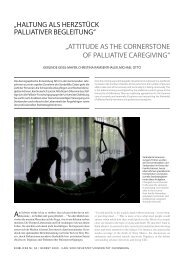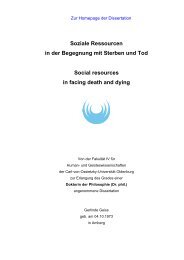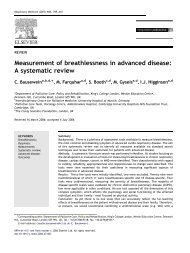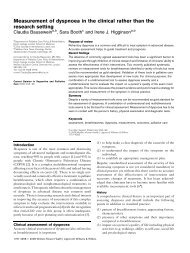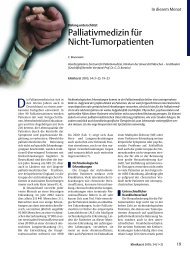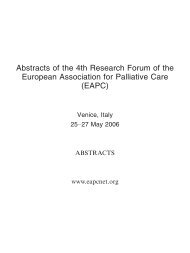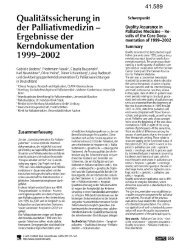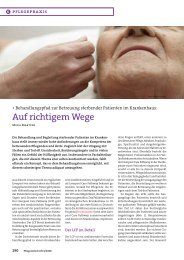EAPC - ipac
EAPC - ipac
EAPC - ipac
You also want an ePaper? Increase the reach of your titles
YUMPU automatically turns print PDFs into web optimized ePapers that Google loves.
446 <strong>EAPC</strong> Abstracts<br />
Background: For decades there has been debate about the best way to ask<br />
patients to rate pain severity. A range of methods has been advocated,<br />
including numerical rating scales from 0 “no pain” to 10 “worst possible<br />
pain” (NRS-11), verbal rating scales with between 4 (VRS-4) to 7 (VRS-7)<br />
response options labelled with verbal descriptors, and visual analogue<br />
scales (VAS). There is extensive literature in the social sciences about rating<br />
scales, mainly dating from the 1950s to the late 1980s, as well as a number<br />
of publications about pain assessment. Two themes emerge. Firstly,<br />
determination of the optimal number of response options when using NRS<br />
or VRS scales. Secondly, comparison of VAS scales against NRS. The exact<br />
number of response options used in a scale is important. One or two extra<br />
options may increase reliability and better reflect the patient-to-patient variability.<br />
But, lengthier scales may increase the time to complete questionnaires,<br />
and place greater cognitive demands on frail patients. Aim: To<br />
review literature on rating scales, supplemented by empirical analyses of a<br />
pain database. Data and statistics: Patient data collected as part of the<br />
EPCRC project have been analysed by item response theory. Conclusions:<br />
Historical studies suggest that VRS with up to 7 options are increasing more<br />
powerful than VRS-4; VRS-5 to VRS-7 are generally preferred by patients<br />
as providing richer and more appropriate choice of response options. The<br />
two main contenders are NRS-11 and VRS-7. Results from analyses of<br />
EPCRC data are consistent with this hypothesis.<br />
Poster N°: 156<br />
Type of presentation: Poster<br />
Poster session: First Group 29 May Thursday, 10.30 to 30 May Friday<br />
13.00<br />
Category: Assessment & measurement tools<br />
Title: Outcomes in Patients Who Had Undergone Internal Hemipelvectomy<br />
(IH) versus External Hemipelvectomy (EH)<br />
Authors:<br />
Ying Guo Palliative Care and Rehabilitation Medicine M. D. Anderson<br />
Cancer Center U. STATES<br />
Karen Zhang M. D. Anderson Cancer Center Houston U. STATES<br />
Be-Lian Pei M. D. Anderson Cancer Center Houston U. STATES<br />
Jeanine Hanohano M. D. Anderson Cancer Center Houston U. STATES<br />
Christina Cote M. D. Anderson Cancer Center Houston U. STATES<br />
J. Lynn Palmer M. D. Anderson Cancer Center Houston U. STATES<br />
Gunjan Sharma M. D. Anderson Cancer Center Houston U. STATES<br />
Guddi Kaur M. D. Anderson Cancer Center Houston U. STATES<br />
Eduardo Bruera M. D. Anderson Cancer Center Houston U. STATES<br />
Background: Introduction: Hemipelvectomy is necessary in treatment of<br />
malignant pelvic tumors. This study compares the rehabilitation need and<br />
functional outcome of patients undergoing an IH versus EH. Methods:<br />
Charts from 30 patients who underwent IH and 30 patients who underwent<br />
EH during 1993–2005 were reviewed. Information collected<br />
include: demographic data; tumor diagnosis and treatment received; postoperative<br />
hospital length of stay (LOS); whether patient required physiatrist<br />
consult and/or acute inpatient rehabilitation stay; the length of rehabilitation<br />
stay; patients’ functional independence measure (FIM) score for<br />
gait upon discharge. We compared differences between the IH and EH<br />
groups using the Wilcoxon rank sum test, Chi-square test, and Fisher’s<br />
exact test. Results: The mean age (range) for IH was 47 (8–80) and 44<br />
(12–75) for EH groups. The male gender was 22/30 (73%) for IH and<br />
15/30 (50%) for EH groups. The preoperative chemotherapy and radiation<br />
treatment are similar between IH and EH groups (p=0.11 and 0.37)<br />
respectively. Rehabilitation consultation and acute in-patient rehabilitation<br />
stay was required for IH group 15/30 (50%) and 13/30 (43%); for EH<br />
16/30 (53%) and 16/30 (53%) respectively (p= 0.8, and 0.44) respectively.<br />
The mean (range) hospital LOS for patients who underwent EH was<br />
significantly longer than those who underwent IH (37 vs.19, p=0.0035).<br />
The mean rehabilitation LOS was similar (20 for EH vs. 22 days for IH<br />
patients, p=0.83). At the time of discharge, significantly higher percent of<br />
IH patients were able to ambulate without another person’s assistance<br />
14/30 (47%) vs. 5/30 (17%) in EH patient group, p=0.0125.<br />
Conclusions: Internal hemipelvectomy with limb salvage seems to be<br />
advantageous over external hemipelvectomy, in both hospital LOS and<br />
short-term functional recovery.<br />
Poster N°: 157<br />
Type of presentation: Poster<br />
Poster session: First Group 29 May Thursday, 10.30 to 30 May Friday<br />
13.00<br />
Category: Assessment & measurement tools<br />
Title: Karnofsky Index and survival<br />
Authors:<br />
Eva Gyllenhammar Löwet Närvård AB ASIH SWEDEN<br />
Jan Adolfsson Onkologiskt centrum Karolinska Universitetssjukhuset Solna<br />
SWEDEN<br />
Eva Thoren-Todoulos ASIH Löwenströmska sjukhuset SE-194 89 SWEDEN<br />
Background: Previous studies have shown that Karnofsky Performance<br />
Index (KPI) < 40 is associated with shorter survival time. In a palliative<br />
home care setting it would be of great value to have easily accessible<br />
tools to assess prognosis in terms of survival. Methods: All patients<br />
admitted to our advanced home care team during 30 months were<br />
assessed with KPI at the first home visit. The patients hade both nonmalignant<br />
and malignant diagnosis and were all in a palliative stage of<br />
their disease. KPI was noted in the electronic file of each patient and the<br />
file could not be completed without the assessment. Six senior doctors<br />
were involved. Results: 579 consecutive patients were included.<br />
One(1)KPI assessment was missing. 152 patients had non-malignant diseases<br />
and 426 had a disseminated cancer with rapidly progressing disease.<br />
The mean KPI at admission was 70. In the non-malignant group<br />
13 % (20/152) died during the study period, and in the cancer group 65%.<br />
(279/426) In the non-malignant group 52 % of the patients had a KPI<br />
equal 60 or lower at admission. The corresponding figure for the cancer<br />
patients was 31 %. For the group as a whole (579 patients) no correlation<br />
was found between KPI and time of survival. In the non-malignant group<br />
there was likewise no correlation to be found. In the malignant group<br />
there was a correlation between KPI and time of survival, which is significant<br />
at the 0,01 level. Conclusions: Our conclusion is that KPI on its<br />
own is not a useful tool to estimate prognosis in terms of time of survival<br />
in a mixed palliative patients’ population. The non-malignant patients<br />
hade a poorer KPI score at admission but a much better survival. In a palliative<br />
cancer patient group KPI might be useful but still approximately<br />
20 % of the patients were “long term survivors”.<br />
Poster N°: 158<br />
Type of presentation: Poster & poster discussion session<br />
Poster session: First Group 29 May Thursday, 10.30 to 30 May Friday<br />
13.00<br />
Category: Assessment & measurement tools<br />
Title: The Alberta Breakthrough Pain Assessment Tool for Research:<br />
A Validation Study<br />
Authors:<br />
Neil Hagen Oncology Tom Baker Cancer Centre and University of Calgary<br />
CANADA<br />
Cheryl Nekolaichuk University of Alberta Edmonton, Alberta CANADA<br />
Patricia Biondo Tom Baker Cancer Centre, Alberta Cancer Board Calgary,<br />
Alberta CANADA<br />
Linda Carlson Alberta Cancer Board and University of Calgary Calgary,<br />
Alberta CANADA<br />
Carla Stiles Tom Baker Cancer Centre, Alberta Cancer Board Calgary,<br />
Alberta CANADA<br />
Kim Fisher Alberta Cancer Board Calgary, Alberta CANADA<br />
Robin Fainsinger Alberta Cancer Board and University of Alberta<br />
Edmonton, Alberta CANADA



